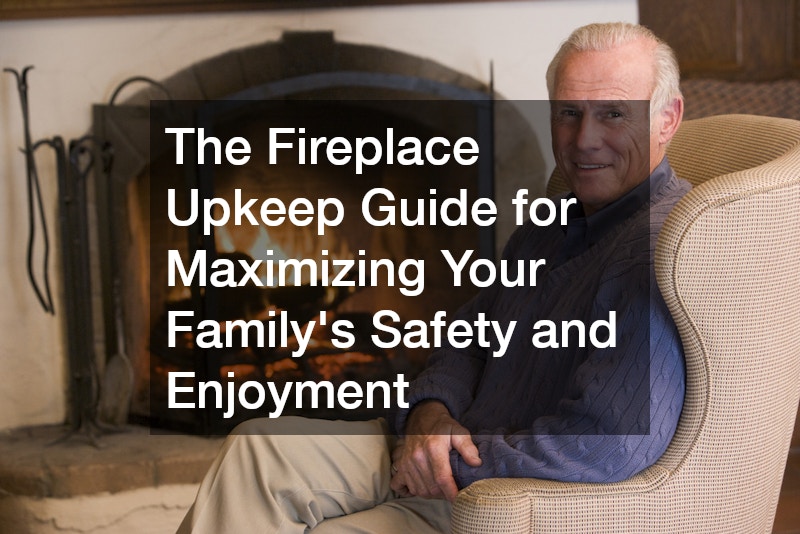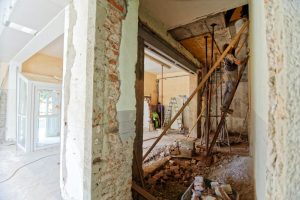A warm, cozy hearth is often the heart of a home, offering comfort, ambiance, and a gathering spot for family and friends. However, to fully enjoy this feature safely and efficiently, regular fireplace upkeep and attention are essential. Without proper attention, risks such as fire hazards or equipment malfunctions can arise, threatening both property and personal safety. This guide is designed to help homeowners understand the importance of regular maintenance and best practices for ensuring their hearth remains both a source of warmth and a safe environment.
Taking care of your home’s heating system requires more than just occasional cleaning. It involves understanding the various types of heating units available, how to use fuel sources properly, and the critical role safety devices play in preventing accidents. Additionally, addressing any structural issues promptly ensures the system operates efficiently and reduces the chances of costly repairs down the line. Working with qualified professionals to inspect and maintain these installations can also enhance safety and prolong their lifespan.
By focusing on proper upkeep, families can enjoy their living spaces worry-free, knowing that every precaution has been taken to reduce fire risks and improve performance. From selecting the right fuel to scheduling regular inspections and cleanings, each step plays a vital role in creating a safe and enjoyable atmosphere. This guide will cover everything from the basics of different hearth types, preventative measures, the importance of safety equipment, and when to seek expert assistance.
This resource empowers homeowners to make informed decisions about their home heating setups, providing peace of mind alongside the cozy comfort they cherish. Whether you’re new to owning a hearth or looking to improve your current maintenance routine, this comprehensive guide aims to enhance your knowledge and encourage consistent care practices. Let’s explore the essential steps for maintaining a safe and inviting home environment centered around your heating system.
1. Types of Hearths

When considering a home fireplace, it’s important to recognize the different types that homeowners can choose from. Hearth varies widely in design and operation, with each type offering distinct benefits and maintenance needs. Understanding these differences is the first step toward proper fireplace upkeep. Whether your home has a traditional wood setup or a modern heating unit, each requires unique care routines to maintain safety and functionality.
Specifically, many homes feature either a wood-fueled hearth or a gas-powered heating element. The wood-fueled variety relies on burning logs to produce heat and ambiance, which requires regular ash removal, chimney inspections, and careful selection of fuel to avoid buildup and hazards. On the other hand, gas-powered units operate with fuel lines and controlled flames, demanding maintenance on gas valves, pilot lights, and ventilation systems. Knowing the characteristics of your particular setup is essential for targeted upkeep.
Delving deeper into each type, wood setups often provide a rustic charm and natural warmth but come with added responsibilities such as managing firewood quality and addressing creosote buildup. Gas units offer convenience and cleaner operation, but must be regularly checked for leaks and proper combustion. Recognizing the unique upkeep demands of your heating type ensures you can plan maintenance effectively and keep your home safe and warm.
2. Safe Maintenance Tips
Maintaining your heating system safely means committing to regular inspections, cleanings, and prompt repairs. Safe maintenance helps prevent dangerous situations such as accidental fires, carbon monoxide leaks, or mechanical failures that could endanger your household. It’s crucial to develop a routine that includes both basic cleaning and professional checkups to catch potential issues early. These actions form the foundation of good fireplace upkeep.
For a gas fireplace, specific tasks include checking pilot lights for proper ignition, inspecting gas lines for leaks, and cleaning vents to ensure adequate airflow. Many homeowners overlook these steps, which can lead to inefficient operation or hazardous conditions. Scheduled servicing by a certified technician can identify wear and tear or malfunctioning parts that might not be obvious but could compromise safety.
Further attention should be paid to the overall ventilation system to prevent the buildup of harmful gases indoors. Filters and vent covers need cleaning or replacement, and any signs of unusual odors or flame discoloration should prompt immediate action. Safe maintenance is not just about preserving warmth; it’s about protecting your family through vigilant upkeep and care.
3. Preventing Fire Risks

Reducing fire risks at home requires a proactive approach, especially when dealing with open flames or heating elements. Proper management and awareness can dramatically decrease the chance of accidents that might cause injuries or property damage. Understanding how fires start and the common causes linked to heating features is vital for effective risk prevention. Fireplace upkeep includes implementing strategies to keep these dangers at bay.
Common fire risks involve unattended flames, buildup of flammable residue, and improper use of fuel or equipment. Educating all family members about safe operation and emergency procedures also plays a key role. Installing and maintaining smoke detectors, keeping flammable materials at a safe distance, and ensuring children and pets stay away from active hearths are all preventive measures that contribute to a safer home environment.
Taking fire prevention a step further means regular professional inspections to identify hidden hazards such as damaged flues, cracked components, or blocked vents. Proper disposal of ashes and ensuring that the area surrounding the hearth remains clean and uncluttered are simple but effective practices. This ongoing vigilance is essential for maximizing safety and enjoyment from your heating system.
4. Handling Wood Properly
For homes with a wood burning fireplace, the quality and handling of fuel significantly impact both safety and performance. Using seasoned, dry wood is crucial because it burns more cleanly, producing less smoke and harmful buildup. Proper storage and selection of wood not only enhance heating efficiency but also reduce maintenance issues. Correct handling is a key component of thorough fireplace upkeep.
Specific storage methods help keep firewood dry and free from pests. Wood should be stacked off the ground in a well-ventilated, covered area to prevent moisture absorption, which can lead to mold and inefficient burning. Avoid burning treated or painted wood, as these materials release toxic fumes and accelerate damage to the chimney and hearth. Homeowners should rotate their supply, using the oldest wood first to maintain a fresh stock.
Going deeper, improper handling can cause creosote buildup in chimneys, increasing fire risk and the need for frequent cleaning. Using the right kind of wood for your climate and hearth design can maximize heat output while minimizing smoke and soot. This attention to detail not only ensures safety but also extends the life of your heating installation.
5. Smoke Detector Benefits

Smoke detection devices are indispensable safety tools for any home with a heating feature. These fire alarms provide early warning of smoke or fire, giving families valuable time to react and evacuate if necessary. Installing, maintaining, and regularly testing these devices is a fundamental part of effective fireplace upkeep and overall household safety.
Specifically, smoke detectors should be installed near all sleeping areas and in rooms with heating units. Battery-powered or hardwired models both work well, but regular battery replacement and system testing are essential to ensure reliability. Many modern alarms also include carbon monoxide detection, which is critical for homes using gas heating elements or with poor ventilation.
In addition to proper placement and upkeep, it’s important to educate household members on what to do when alarms sound. Routine drills can prepare families for emergencies, reducing panic and improving response times. A well-maintained smoke detection system is one of the simplest and most effective ways to protect your loved ones and your property from fire hazards.
6. Choosing Fire Safety Tools
Having the right safety tools on hand is a crucial aspect of protecting your home against fire-related emergencies. Portable suppression devices are designed to quickly control small fires before they escalate, making them an important part of your overall safety plan. Selecting the appropriate equipment and knowing how to use it correctly is key to effective fireplace upkeep and risk management.
Specifically, various types of fire suppressors are available, including multipurpose units suitable for common household fires involving wood, fabric, or electrical components. When purchasing these devices, consider their size, ease of use, and certification to ensure they meet safety standards. Consulting with a reputable supplier specializing in fire extinguisher sales can help you find the best fit for your home’s unique needs.
Going further, proper placement of these tools near the heating area but away from heat sources ensures quick access during an emergency. Regular inspection and servicing of your extinguishers keep them operational and ready when needed. Additionally, family members should be trained on how to operate these devices safely, boosting confidence and preparedness in critical moments.
7. Sprinkler System Basics

Automatic suppression systems offer an added layer of security by detecting and controlling fires without manual intervention. These systems use a network of pipes and nozzles to release water or other agents when heat triggers them. Integrating such technology with your home’s heating feature can greatly reduce fire damage and increase family safety, making it an important consideration in fireplace upkeep.
In practice, a specialized fire sprinkler company will install and maintain these systems, tailoring them to the size and design of your residence. Proper installation ensures coverage of vulnerable areas, including near hearths and other potential ignition points. Regular inspections are essential to verify the system’s readiness and to address any issues like leaks, corrosion, or faulty valves.
Beyond installation, homeowners should familiarize themselves with how the system operates and how to shut it off if necessary to prevent water damage. Sprinkler systems complement other fire safety measures by offering continuous protection and reducing reliance on manual suppression, providing peace of mind for families.
8. Fixing Chimney Issues
The chimney plays a vital role in venting smoke and gases safely outside your home, so maintaining its structural integrity is critical. Damage such as cracks, blockages, or deterioration can impair function and increase fire hazards. Timely chimney repairs and regular inspections are foundational steps in effective fireplace upkeep and overall safety management.
When addressing chimney problems, common issues include creosote buildup, masonry cracks, and damaged flashing. Creosote, a highly flammable residue, accumulates from burning wood and must be cleaned frequently to prevent chimney fires. Structural damage can allow dangerous gases to seep into living areas, posing health risks that require immediate attention.
Moreover, ensuring the chimney cap and crown are intact protects against weather damage and animal intrusion, which can cause further complications. Engaging certified contractors for thorough assessments and repairs extends the life of your chimney and safeguards your home from fire and toxic exposure.
9. Contractor Safety Checks
Engaging qualified construction professionals helps ensure that your heating feature complies with safety codes and operates efficiently. These experts assess installation quality, identify potential hazards, and recommend upgrades or repairs. Their involvement is a vital part of comprehensive fireplace upkeep, supporting long-term safety and performance.
Specifically, a building contractor will evaluate structural elements such as hearth supports, ventilation, and clearances from combustible materials. They also verify that gas or wood heating systems meet local regulations and manufacturer specifications. This proactive approach can prevent costly mistakes and reduce fire risks associated with improper installation or aging components.
Further, contractors often coordinate with other specialists, such as chimney experts and safety equipment providers, to create an integrated safety plan for your home. Their expertise not only addresses immediate concerns but also helps future-proof your heating setup against evolving safety standards.
10. Seasonal Cleaning Guide
Regular cleaning and maintenance routines vary by season, but all contribute to safe, efficient heating system operation. Clearing out debris, checking for damage, and preparing your system for colder months are important fireplace upkeep tasks that support family safety and comfort year-round.
During colder seasons, it’s essential to ensure that firewood is dry and properly stored to minimize smoke and buildup. Cleaning ash residues and inspecting firebox components helps maintain airflow and combustion efficiency. Off-season, taking the time to inspect and repair any damage prevents problems from worsening before the next heating cycle.
Additionally, seasonal cleaning includes checking safety devices, ventilation pathways, and seals. This thorough approach reduces risks such as blockages or leaks that could cause fire or health hazards. Keeping a consistent maintenance schedule aligned with seasonal changes ensures your home remains warm, inviting, and safe.
Proper fireplace upkeep is essential not only for maintaining the comfort and ambiance a heating feature provides but also for ensuring the safety of your family and home. As we have explored, a thorough understanding of various aspects—from choosing the right safety tools to seasonal maintenance—plays a pivotal role in minimizing risks and enhancing enjoyment. Taking the time to care for your system through regular inspections, repairs, and upgrades helps prevent dangerous situations and extends the lifespan of your equipment.
Seasonal cleaning and preparation complete the cycle of care. Adjusting maintenance routines to the time of year, from fuel storage to thorough inspections, keeps the system running efficiently and safely. Regular upkeep mitigates issues before they become emergencies, protecting both your family’s well-being and your investment.
Maximizing safety and enjoyment from your heating feature demands consistent, knowledgeable care. By combining proper safety equipment, professional guidance, diligent chimney repairs, and routine seasonal maintenance, you create a secure and welcoming atmosphere for your household. Embracing this holistic approach to fireplace upkeep ensures that your home remains a cozy retreat throughout the year, free from unnecessary risks and full of warmth.




